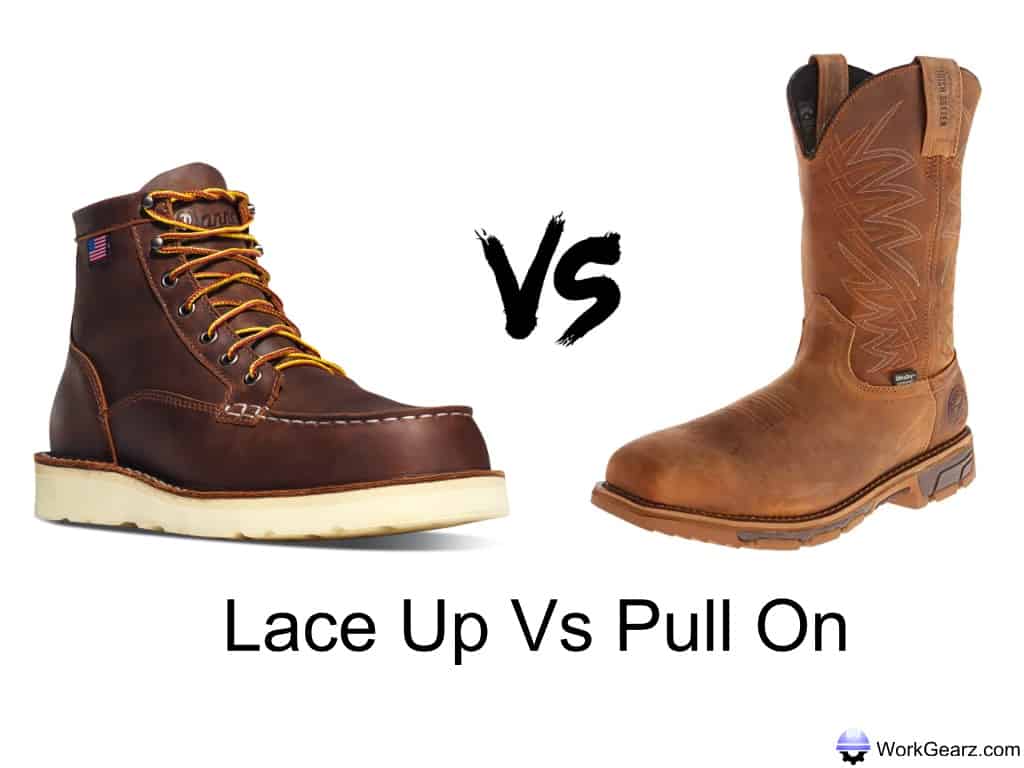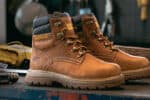There has always been a debate around regarding the selection of safety footwear. A pair of work-boots, which is the appropriate pick for you, is just a matter of your style and convenience.
Today we will witness a tug-of-war between Pull-on and Lace-up work-boots!
Quite interesting! The competition will be tough enough.
To be very precise both the pull-on and lace-up work-boots have their own areas of excellence. Neither of them is perfectly better than the other in general terms. Their differences may be glaring but they both offer great benefits. As a matter of fact, lace-up boots give greater ankle support, whereas the pull-on boots are very convenient for wearing and taking off. Still, we ought to justify this contrast. So, stick to the discussion given below.
Witness the comparison between these two types based on better ankle support, ease of wearing and pulling off, protection and comfort level, proper fitting and potential exposure to falls, for their users.
Time to scroll down!
Briefly Defining Both the Work-Boots
What is Pull-On Work-Boots?
These boots come without laces, as the name depicts. They are very easy to wear and take off, involving minimum time period. These boots are mainly meant for workers of oil rigs, who need to pull on and off their work-boots, quite often.
They are constructed into the right shape and size for a proper fit around the foot. Materials like genuine leather, synthetic leather, nylon mesh, and foam are used to manufacture these boots. These boots represent tough and durable footwear.
Check out video on top pull on work boots
What are Lace-Up Work-Boots?
As the name implies, these boots come with a lace material to adjust proper fitting and grip on the feet. These boots offer high ankle support to your feet because of the shoelaces going through the lugs of your boots.
They look and feel rugged and durable. These boots are very popular among construction workers and people involved in outdoor professions. These boots are made of full-grain high quality leather and sometimes rubber and fabric.
Lace-up boots lead to more productivity, look very professional, very durable and can sometimes eliminate the fatigue you need to deal with, every day.
Comparison Table Between Pull-On and Lace-Up Work Boots
| Features | Pull-On Work-Boots | Lace-Up Work-Boots |
| Proper Fit | Satisfactory but sometimes may lose shape with time. | Very much up to the mark with desired snugness. |
| Convenience | Much easier to wear and pull off. Involves less time. | The laces of these boots needs to be tied which takes time and you have to bend or kneel down for that. |
| Protection | Can offer great foot protection as long as you make the right choice that suits your profession. | The lace system secures your feet making them safer to wear. |
| Traction Level | Provides better traction by lessening the chances of tripping, slipping or falling down. | Here, the laces can sometimes expose you to slips or trips, if they are hanging loose. |
| Ankle Support | Offers zero degree of support to your ankles. | Offers high level of ankle support to your feet. |
Features Overviewed in Details:
1.) How well do these boots Fit
Pull-On Work-Boots Fit
It is quite challenging for the pull-on boots to provide proper fit because of their no-laces character. Moreover, if you choose the wrong pair, it will definitely lead to discomfort and pain.
These boots are usually not made for a single individual, unless you customize them. General foot shape is used in these boots rather than the specific one.
They start losing their original shape, in due time. The manufacturers are constantly trying to improve the quality of these work boots, so that they can come out with the best designs that fits your feet.
Lace-Up Work-Boots Fit
The laces in these boots can easily manipulate your fitting criteria. Adjusting the laces can, at times tighten your boots giving you more snugness, and loosening them, giving you more space.
These boots are quite long-lasting. Tying up the laces can sometimes create hassles for you but they can superior comfort and control in the long run.
Lace-up boots keep debris out from your feet. They are designed to give better heel support and lowers your risk of getting injuries. If, by any chance your boots get out of shape in due time, you can still adjust them to fit you nicely, with the help of the laces.
2.) Convenience to Wear
Pull-On Work-Boots are easy on and off
As these boots come without laces, you can very easily slip your feet inside them with very little effort and also pull them off, when you don’t need them.
These boots are meant solely for people working in oil rigs. All Rigger Boots are pull-on work-boots. They are versatile in terms of appearance and can be worn with both formal and casual outfits.
These boots edge out lace-up boots in the degree of convenience and ease that comes with putting them on and taking them off, several times.
Lace-Up Work-Boots takes time to wear
To put on these boots, you need to bend or kneel down to reach your feet and tie the laces, to secure your feet.
Putting on lace-up boots is a time-taking factor for users. These boots can be customized as per your requirements. Choose the right type to suit your working conditions.
3.) Protection/Safety
Pull-On Work-Boots safety features
These boots can protect you from falls, electrical hazards, punctures and injuries. As these boots don’t have any laces, you have the minimum chances of tripping, by getting caught in low hanging corners.
They are both oil-resistant and water-resistant. The only drawback of these boots is, as they are usually loose around the legs, dust or dirt particles can enter your boots, making your feet uncomfortable.
Lace-Up Work-Boots safety features
These boots can also save your feet from any and every hazards. Lace-up boots can prevent debris from getting into your feet, making them safer to wear. Just be careful from getting tangled due to the laces and hence tripping or falling down.
Avoid getting exposed to chemicals with these boots as they can damage your footwear and your skin. They come with good amount of toe and outsole safety features.
4.) Traction Level
Pull-On Work-Boots
These boots always provide better traction to your feet, minimizing the chances of tripping or falling down, when you are busy working.
Lace-Up Work-Boots
If the laces of your boots are lengthy and loose, they can get caught in stuff lying around your working place, causing various kinds of accidents.
Your feet can get tangled and you can fall down resulting into injuries. This lace system of these boots, is the only reason for providing inadequate traction level.
5.) Ankle Support
Pull-On Work-Boots
They lack in providing proper ankle support to your feet.
Lace-Up Work-Boots
These boots promise much better support to your ankles, making your feet stable and comfortable.
6.) Strengths and Weaknesses
Pull-On Work-Boots Strengths
These boots are effortless while putting them on or taking them off. They are generally tall to provide extra protection. These boots are available in varied designs.
As, they don’t have any laces, your chances of tripping or falling down lessens. These boots are the first preference for oil industry rig workers.
The ventilation system of these boots are much better for your feet which can prevent foot odor. They have less stitching and lace openings which makes them waterproof.
Lace-Up Work-Boots Strengths
These boots offer a guaranteed secure fit. As they can be customized, your feet gets the best comfort and stability. These are available in various styles and designs.
They can give you better ankle support. These boots serves you for a long period, even if they lose their shape. Construction industry workers commonly uses these boots for better ankle support and less chances of punctures.
Pull-On Work-Boots Weaknesses
Sometimes due to the gapping collars, these boots cannot provide enough warmth and safety. They cannot support your ankles. Eventually, they start losing their shape. Most of them are not puncture-resistant.
Lace-Up Work-Boots Weaknesses
They involve time and effort to put on and take off. With time the laces of these boots might need replacement. If, by any chance, the laces of your boots are lengthy or are hanging out, you have the maximum chances of tripping over or falling down, while you are busy working.
The ventilation process of these boots is very poor. These boots can make your feet sweaty, very often, resulting into foot odor.
7.) When to Use These Boots
Pull-On Work-Boots
People working in fields of agriculture, farming, gardening, wielding and mainly oil industry rig workers, commonly uses these pull-on boots. For them fussing with lace adjustments or ties, is not at all acceptable.
If you are working in chemical industries, the chances of your boots getting caught or spilled on by harmful chemicals, lessens, because your boots don’t have laces. This lace-less design gives you streamlined protection.
Lace-Up Work-Boots
These boots encloses your feet completely, preventing it from debris falling inside. If you are working in fields with metal fragments, shattered glasses, sand, sparks of flames, fiberglass, etc. lace-up boots should be your initial choice.
These boots offer better stability to the feet of those people who need to stand or move around for long hours.
Listed Queries and Solutions:
List the most popular and comfortable pull-on work-boots.
Few best pull-on work-boots are-
| Image | Title | Buy |
|---|---|---|
 Top
Top Top
Top | Irish Setter Men's 83907 Wellington | Buy on Amazon |
 Top
Top Top
Top | Timberland PRO Men's AG Boss Pull-On Alloy Toe | Buy on Amazon |
 Top
Top Top
Top | Ariat Men's Workhog Pull-on H2O Composite Toe | Buy on Amazon |
What are the best lace-up work-boots?
Few best lace-up boots are-
| Image | Title | Buy |
|---|---|---|
 Top
Top Top
Top | Danner Men’s Bull Run | Buy on Amazon |
 Top
Top Top
Top | Irish Setter Men's 83624 | Buy on Amazon |
 Top
Top Top
Top | Wolverine mens Raider | Buy on Amazon |
Are lace-up boots safer than slip on?
Definitely yes!
Lace up boots are way safer than the slip on shoes and the reason behind this is with lace up boots you get the perfect fitting of the boots according to your own comfort; whether you enjoy a tight fit or a snug fit. Whereas, with the slip on shoes, where there are no laces, you have to compromise with the fit that the shoe already has!
The laces provide a good grip to the feet so that the feet remain in position instead of moving forward or backward or to the right or left.
If the slip-on boots or shoes are too loose, there remains the danger of the heel coming out of the shoes while walking and as a result, you might face accidents due to falling or tripping. But with the lace-up boots this will never be the case.
How should pull-on work-boots fit?
Your toes should not slide forward and hit the end of your boot. The heels of your feet should not rub against the inner-back side of your boot.
The sided of your feet should not feel pressurized or in pain. There should be at least 1 inch of space inside your boots.
Why are Rigger Boots banned?
Some consider these Rigger Boots as a looser fit and cannot prevent twisting of the feet. That is why these boots are not accepted on some work-fields. Though this argument needs proper understanding and compliance.
Climax
After elaborating almost all the aspects, now at the end, I assume, you might have gained a crystal-clear opinion.
Whether it is the Lace-up or the Pull-on, your safety and comfort shouldn’t get compromised, at any cost. While thinking of choosing any of these above work-boots, remember to consider your protection, a priority.
The key-point is– ‘The best boot style for you is the one which your job requires and which can safeguard your feet’.
I, honestly appreciate and, am, very thankful to our readers for their interests and involvements, regarding my writing. This act of yours encourages me and my team a lot.
Continue being with us in future. I am very eager for your reviews.
Coming up soon!
Till then!
Stay tuned!








